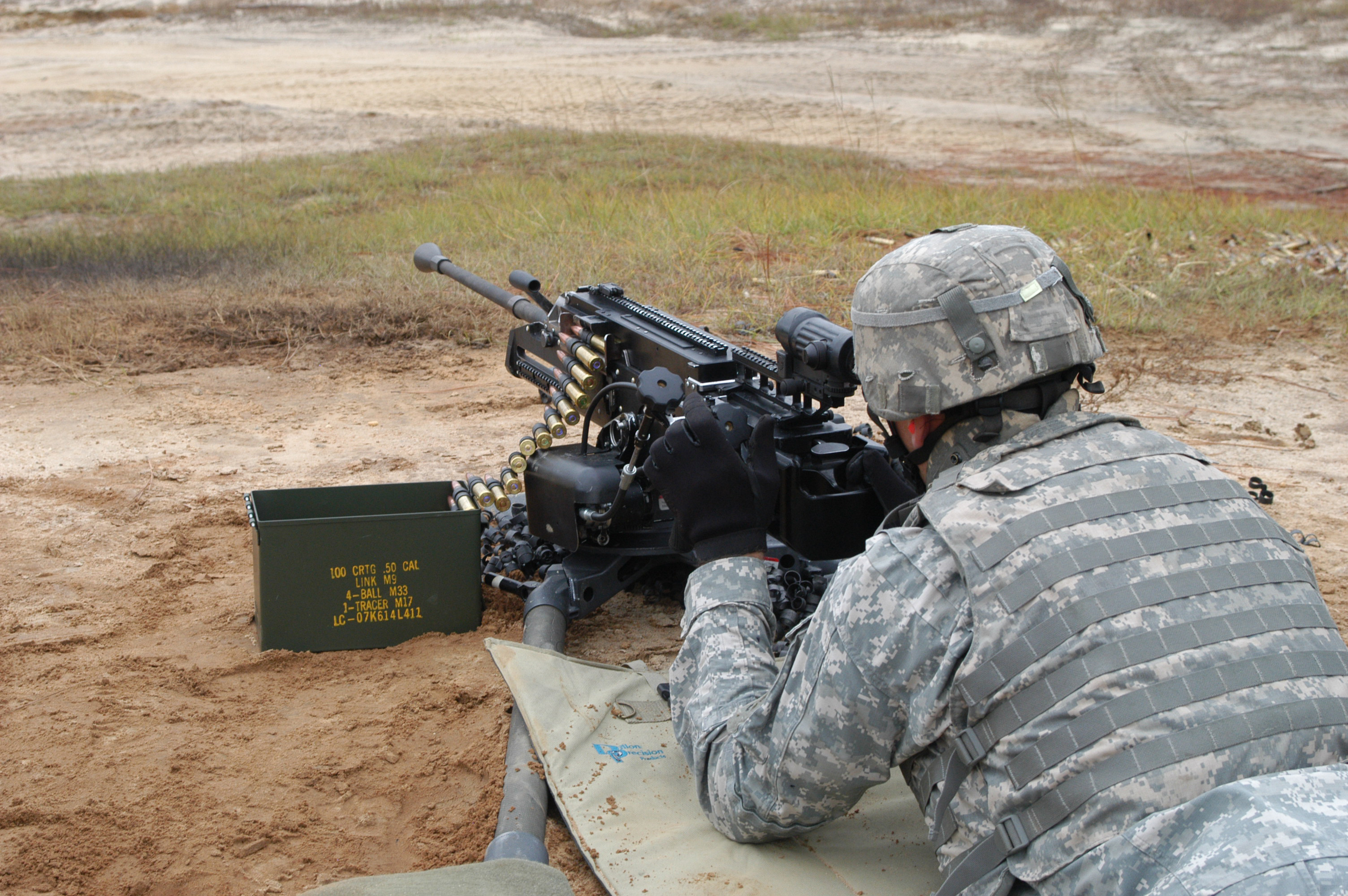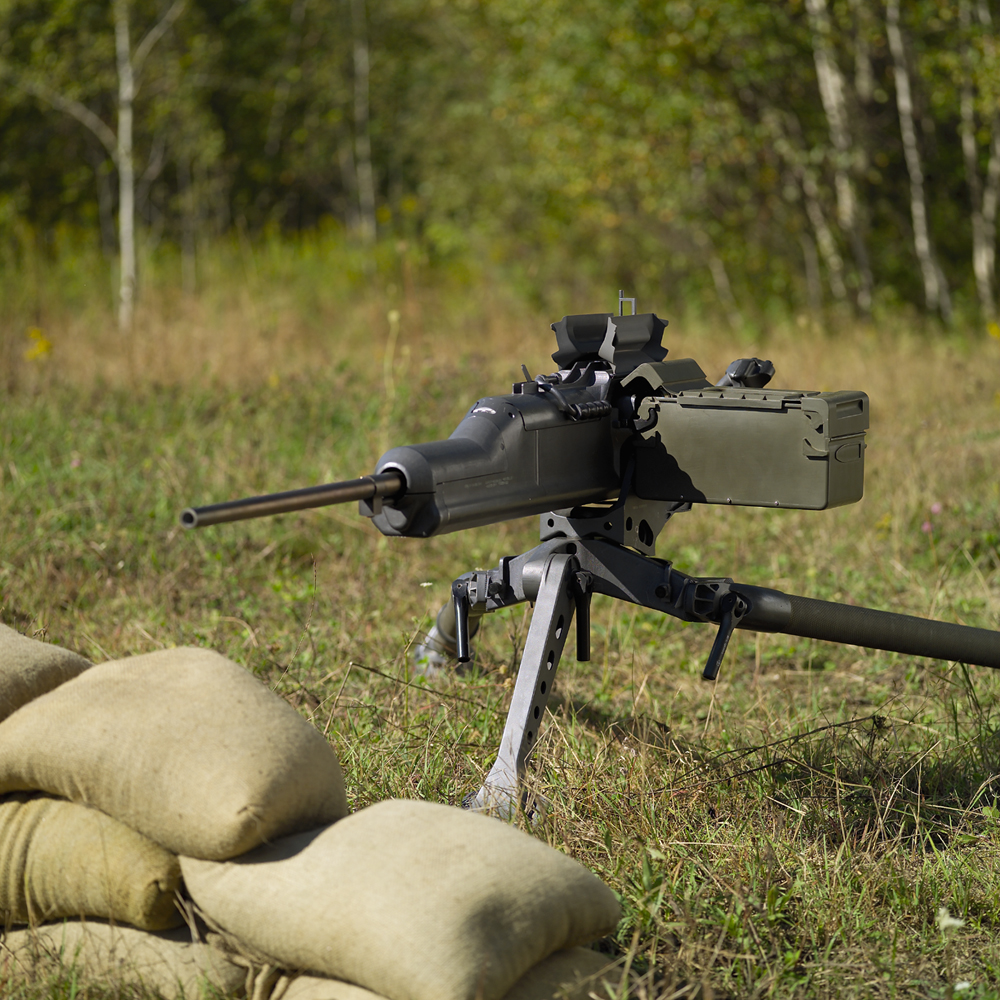|
XM312
The XM312 is a heavy machine gun derived from the XM307 25 mm autocannon and chambered for the .50 BMG cartridge. It was designed in response to a request by the U.S. military for a replacement for the aging M2 Browning heavy machine gun, and as a complement to the heavier XM307 Advanced Crew Served Weapon grenade launcher. It is capable of being converted quickly into an XM307 with a small number of parts and a few minutes of work at the unit level (and vice versa from the XM307). The Fiscal Year 2008 Appropriations bill awarded $10 million to General Dynamics for the XM307 and XM312. In May 2008 the U.S. Army had awarded General Dynamics Armament and Technical Products (GDATP) a $9 million contract to develop a lightweight .50-caliber machine gun called the XM806 to supplement the Browning M2. The XM806 was canceled in 2012. The Army at present will continue buying new M2s and Mk 19s to replenish the current guns that are wearing out. Specifications * Weight: ** Weig ... [...More Info...] [...Related Items...] OR: [Wikipedia] [Google] [Baidu] |
XM307 Advanced Crew Served Weapon
The XM307 Advanced Crew Served Weapon (ACSW) was a developmental 25 mm belt-fed automatic grenade launcher with programmable airburst capability. It is the result of the '' OCSW'' or ''Objective Crew Served Weapon'' project. It is lightweight and designed to be two-man portable, as well as vehicle mounted. The XM307 can kill or suppress enemy combatants out to 2,000 meters (2,187 yd), and destroy lightly armored vehicles, watercraft, and helicopters at 1,000 meters (1,094 yd). The project was canceled in 2007. Overview The system was under development by General Dynamics Armament and Technical Products for the U.S. Army Tank-Automotive and Armaments Command (TACOM). As a part of the ''Small Arms Master Plan'' (SAMP) program, it is intended to either replace or supplement the Mk19 automatic grenade launcher and the M2 heavy machine gun. It fires 25 mm point-detonating and air burst style ammunition, including HE, and HEAT at a cyclic rate of 260 rounds per minute and h ... [...More Info...] [...Related Items...] OR: [Wikipedia] [Google] [Baidu] |
XM307
The XM307 Advanced Crew Served Weapon (ACSW) was a developmental 25 mm belt-fed automatic grenade launcher with programmable airburst capability. It is the result of the ''OCSW'' or ''Objective Crew Served Weapon'' project. It is lightweight and designed to be two-man portable, as well as vehicle mounted. The XM307 can kill or suppress enemy combatants out to 2,000 meters (2,187 yd), and destroy lightly armored vehicles, watercraft, and helicopters at 1,000 meters (1,094 yd). The project was canceled in 2007. Overview The system was under development by General Dynamics Armament and Technical Products for the U.S. Army Tank-Automotive and Armaments Command (TACOM). As a part of the ''Small Arms Master Plan'' (SAMP) program, it is intended to either replace or supplement the Mk19 automatic grenade launcher and the M2 heavy machine gun. It fires 25 mm point-detonating and air burst style ammunition, including HE, and HEAT at a cyclic rate of 260 rounds per minute and has ... [...More Info...] [...Related Items...] OR: [Wikipedia] [Google] [Baidu] |
XM806
The XM806 Lightweight .50 Caliber Machine Gun (LW50MG) was a developmental .50 caliber belt-fed heavy machine gun.XM806 on PEO Soldier Development began in 2009 and was cancelled in 2012. Design  The XM806 weighed about less (49% lighter), had 60% less recoil than the M2, and had a greater rate of fire than the failed previous attempt to replace the M2, the
The XM806 weighed about less (49% lighter), had 60% less recoil than the M2, and had a greater rate of fire than the failed previous attempt to replace the M2, the
|
50 BMG
The .50 Browning Machine Gun (.50 BMG, 12.7×99mm NATO and designated as the 50 Browning by the C.I.P.) is a caliber cartridge developed for the M2 Browning heavy machine gun in the late 1910s, entering official service in 1921. Under STANAG 4383, it is a standard service cartridge for NATO forces as well as many non-NATO countries. The cartridge itself has been made in many variants: multiple generations of regular ball, tracer, armor-piercing (AP), incendiary, and saboted sub-caliber rounds. The rounds intended for machine guns are made into a continuous belt using metallic links. The .50 BMG cartridge is also used in anti-materiel rifles. A wide variety of ammunition is available, and the availability of match grade ammunition has increased the usefulness of .50 caliber rifles by allowing more accurate fire than lower quality rounds. History In response to the need for new anti-aircraft weaponry during World War I, John Browning developed the .50 BMG. He wante ... [...More Info...] [...Related Items...] OR: [Wikipedia] [Google] [Baidu] |
Heavy Machine Gun
A heavy machine gun (HMG) is significantly larger than light, medium or general-purpose machine guns. HMGs are typically too heavy to be man-portable (carried by one person) and require mounting onto a weapons platform to be operably stable or tactically mobile, have more formidable firepower, and generally require a team of personnel for operation and maintenance. There are two generally recognized classes of weapons identified as HMGs. The first are weapons from World War I identified as "heavy" due to the weight and cumbersomeness of the weapons themselves, which prevents infantrymen from transporting on foot, such as the M1917 Browning machine gun. The second are large-caliber (12.7×99mm, 12.7×108mm, 14.5×114mm, or larger) machine guns, pioneered by John Browning with the M2 machine gun, designed to provide increased effective range, penetration and destructive power against covers, vehicles, aircraft and light buildings/fortifications beyond the standard-calib ... [...More Info...] [...Related Items...] OR: [Wikipedia] [Google] [Baidu] |
Ammunition
Ammunition (informally ammo) is the material fired, scattered, dropped, or detonated from any weapon or weapon system. Ammunition is both expendable weapons (e.g., bombs, missiles, grenades, land mines) and the component parts of other weapons that create the effect on a target (e.g., bullets and Warhead, warheads). The purpose of ammunition is to project a force against a selected Targeting (warfare), target to have an effect (usually, but not always, lethal). An example of ammunition is the firearm Cartridge (firearms), cartridge, which includes all components required to deliver the weapon effect in a single package. Until the 20th century, black powder was the most common propellant used but has now been replaced in nearly all cases by modern compounds. Ammunition comes in a great range of sizes and types and is often designed to work only in specific weapons systems. However, there are internationally recognized standards for certain ammunition types (e.g., 5.56×45mm N ... [...More Info...] [...Related Items...] OR: [Wikipedia] [Google] [Baidu] |
Mk211
The Raufoss Mk 211 is a .50 BMG (12.7×99mm NATO) multi-purpose anti-materiel high-explosive incendiary/armor-piercing ammunition projectile produced by Nammo under the model name ''NM140 MP''. It is commonly referred to as ''multipurpose'' or ''Raufoss'', meaning '' red waterfall'' in Norwegian. This refers to Nammo's precursor company Raufoss Ammunisjonsfabrikker, an ammunition manufacturer established 1896 in Raufoss, Norway. The "Mk 211" name comes from the nomenclature ''Mk 211 Mod 0'' used by the U.S. military for this round. Design details The multipurpose concept developed by Raufoss is unique in that, instead of using a mechanical fuse, it uses a pyrotechnical ignition train to ensure proper deflagration (not detonation) of the explosive and incendiary components. The multipurpose name is based on an armor-piercing tungsten core, a slow explosive, and an incendiary component, thus making it capable of penetrating lightly armored targets and causing damage to personnel ... [...More Info...] [...Related Items...] OR: [Wikipedia] [Google] [Baidu] |
Milliradian
A milliradian ( SI-symbol mrad, sometimes also abbreviated mil) is an SI derived unit for angular measurement which is defined as a thousandth of a radian (0.001 radian). Milliradians are used in adjustment of firearm sights by adjusting the angle of the sight compared to the barrel (up, down, left, or right). Milliradians are also used for comparing shot groupings, or to compare the difficulty of hitting different sized shooting targets at different distances. When using a scope with both mrad adjustment and a reticle with mrad markings (called an "mrad/mrad scope"), the shooter can use the reticle as a ruler to count the number of mrads a shot was off-target, which directly translates to the sight adjustment needed to hit the target with a follow up shot. Optics with mrad markings in the reticle can also be used to make a range estimation of a known size target, or vice versa, to determine a target size if the distance is known, a practice called "milling". Milli ... [...More Info...] [...Related Items...] OR: [Wikipedia] [Google] [Baidu] |
Recoil
Recoil (often called knockback, kickback or simply kick) is the rearward thrust generated when a gun is being discharged. In technical terms, the recoil is a result of conservation of momentum, as according to Newton's third law the force required to accelerate something will evoke an equal but opposite reactional force, which means the forward momentum gained by the projectile and exhaust gases ( ejectae) will be mathematically balanced out by an equal and opposite momentum exerted back upon the gun. In hand-held small arms, the recoil momentum will be eventually transferred to the ground, but will do so through the body of the shooter hence resulting in a noticeable impulse commonly referred to as a "kick". In heavier mounted guns, such as heavy machine guns or artillery pieces, recoil momentum is transferred to the Earth's surface through the platform on which the weapon is mounted. In order to bring the rearward moving gun to a halt, the momentum acquired by t ... [...More Info...] [...Related Items...] OR: [Wikipedia] [Google] [Baidu] |
Vehicle
A vehicle (from la, vehiculum) is a machine that transports people or cargo. Vehicles include wagons, bicycles, motor vehicles ( motorcycles, cars, trucks, buses, mobility scooters for disabled people), railed vehicles ( trains, trams), watercraft (ships, boats, underwater vehicles), amphibious vehicles ( screw-propelled vehicles, hovercraft), aircraft ( airplanes, helicopters, aerostats) and spacecraft.Halsey, William D. (Editorial Director): ''MacMillan Contemporary Dictionary'', page 1106. MacMillan Publishing, 1979. Land vehicles are classified broadly by what is used to apply steering and drive forces against the ground: wheeled, tracked, railed or skied. ISO 3833-1977 is the standard, also internationally used in legislation, for road vehicles types, terms and definitions. History * The oldest boats found by archaeological excavation are logboats, with the oldest logboat found, the Pesse canoe found in a bog in the Netherlands, being carbon ... [...More Info...] [...Related Items...] OR: [Wikipedia] [Google] [Baidu] |
United States Army
The United States Army (USA) is the land warfare, land military branch, service branch of the United States Armed Forces. It is one of the eight Uniformed services of the United States, U.S. uniformed services, and is designated as the Army of the United States in the United States Constitution, U.S. Constitution.Article II, section 2, clause 1 of the United States Constitution (1789). See alsTitle 10, Subtitle B, Chapter 301, Section 3001 The oldest and most senior branch of the U.S. military in order of precedence, the modern U.S. Army has its roots in the Continental Army, which was formed 14 June 1775 to fight the American Revolutionary War (1775–1783)—before the United States was established as a country. After the Revolutionary War, the Congress of the Confederation created the United States Army on 3 June 1784 to replace the disbanded Continental Army.Library of CongressJournals of the Continental Congress, Volume 27/ref> The United States Army considers itself to be ... [...More Info...] [...Related Items...] OR: [Wikipedia] [Google] [Baidu] |






.jpg)
